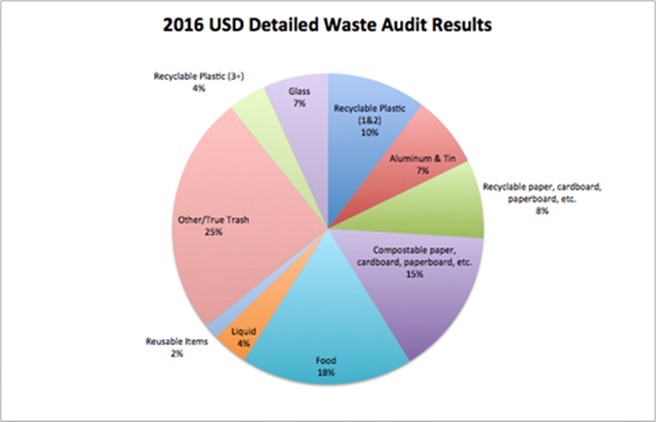
Pilot recycling program moving to next round of discussion
The USD waste and recycling study report is almost finished and ready to be taken to the Executive Committee to review a pilot program.
The report includes data from multiple studies done last year. Including recycling rates, a waste profile assessment, infrastructure assessment and sustainability survey.
According to the report, done by the Verdis group, an Omaha-based environmental consulting firm, the recycling rate for the fiscal year of 2015 was 6.9 percent recycling and 93.1 waste.
The waste profile assessment included multiple parts like a waste audit and
dumpster peek.
The waste audit found that 43 percent of materials in the trash were compostable. The other 37 percent of waste was appropriately going to the landfill.
Junior and psychology major Aimee Wieczorek said she feels the university could probably do a better job.
buy finasteride online https://blackmenheal.org/wp-content/languages/new/us/finasteride.html no prescription
“I mean it looks like we are doing a good job but if that much is still going to the landfill that isn’t very good,”
Wieczorek said.
Wieczorek’s friend, Sydney Bush, a sophomore communication disorders major, also agreed that USD could work on their recycling program.
“I think recycling could be better in the dorms. But it needs to be easy, too. I know at my sorority house it’s really easy for me to recycle,” Bush said. “We could do a better job if it was easy.”
The dumpster peek showed the committee that, more than likely, there are several dumpsters and containers that aren’t being used to their
full potential.
In the infrastructure assessment, the Verdis group, with help from Dr. Meghann Jarchow’s SUST 489 course, went around campus and took an inventory of locations, styles and sizes of waste receptacles. They found that USD had too many of some types of waste receptacles and not enough
of others.
In the assessment they organized receptacles into six categories:
W1 – A nice, common area waste container similar to those found in the Muenster University Center
W2 – A common area water container, but not as nice as those found in the MUC
W3 – A small, below-the-knee waste container
R1 – A nice, common area recycling containers similar to those found in the MUC
R2 – A common area waste container, but not as nice as those found in the MUC
R3 – A small, below-the knee recycling container – often cardboard box
Here were the results:
The sustainability survey sent to students and staff received 1,056 total responses — 699 responses were students and 387 were
university employees.
Eighty percent of responses said that recycling at USD was important to them and 88 percent said sustainability at USD was important to them.
The report, however, highlights the amount of misinformation students have on recycling. Up to 40 percent of respondents weren’t sure or were wrong about what can be recycled
on campus.
The survey also found that printing class notes, lecture slides and writing assignments made up 75 percent of
all printing.
Moving Forward
Now that the President’s Committee on Sustainability has the report, they’re meeting with Facilities Management and Craig Moody, a consultant at the Verdis group, today to discuss the viability of alternate plans that were given to the committee.
Scott Pohlson, the Chair of the Presidents Committee on Sustainability says the objective of the meeting is to see what Facilities Management can realistically do in a pilot program.
“The goal is to see what Facilities Management can do,” Pohlson said. “Because I want to go to the (executive) committee and say this is how you do it, no questions asked.”
Pohlson said that the next meeting could wait awhile, however.
“The State of the University is coming up and so that is our focus right now,” Pohlson said. “And then we are getting close to D-Days which takes up time. So probably Oct. 10 we will meet
with them.”
In the report, the timeline for October was to start preparing communication to students and staff that a pilot was happening, conduct pre-pilot surveys, establish training and train custodial staff and others on how the pilot
will work.
Pohlson said he’s not sure where the process will be come October.
“I have no idea how much these things end up costing…I didn’t think through the fact that we would need to think through their (Facilities Management) limits, because they are overworked,” Pohlson said. “It’s not that they are limiting us; it’s they don’t have enough resources. Some action will be started in October but how one might define action is
what’s interesting.”
While Pohlson doesn’t know what the pilot will look like or exactly what building it will be in, he can confirm it won’t be in any residence halls.
“It will start in an administrative building,” he said. “It needs to be a space where it can show us the ups and downs when we take it to anther facility. We want it in a location where the decision-makers can see it and say this works or doesn’t work.”

